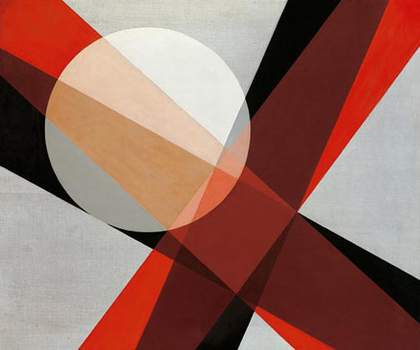Victor Moscoso
I studied with Josef Albers at Yale. No one would ever call him Joe; it was always Mr Albers. He was a nice guy, but you couldn’t share a beer with him. He could be very dogmatic and get angry. What was clear was that he was the master and you were the student. I remember one day a student in the class asked him: “Mr Albers, I am confused. Last week you said X, this week you said Y, and they seem to contradict each other,” to which Albers immediately replied: “Young lady, in that case you have a choice.”
He saw painting as colour and got rid of design, layout and perspective, reducing it to a formula. But there was much more to him than that. He introduced me to haiku poetry, for example, which might sound strange, but when you think about the idea of “less is more”, then it makes sense.
He was a showman who knew what he was talking about. I always enjoyed his classes. He knew that when you stand in front of 30 students you have an audience; you must stop thinking of yourself as a painter and more like a musician or poet, because you are communicating with your body language and words, not drawing or painting. He had these exercises in his colour class that drove everyone crazy. One was how to make a colour look like two different ones. You had to choose the background colour and change it until you got the right mix, using all colours from the spectrum. Your retina conflicts with what you see – it is a visual trick. Albers was able to make it as close to a science as is humanly possible.
At first his teaching didn’t fit into my work. I was using black and white, with earth tones, mainly because they were cheaper. In 1966 I saw a poster by Wes Wilson with all its vibrating colours, and suddenly a light came on in my head – all the information and all the teaching from Albers fell into place. Then I vibrated every edge of every colour in my posters. So I can say he was a really influential teacher. And because Albers was forced out of Germany by Hitler, I got to work with the genius of colour. I should send Hitler a postcard, saying: “Hey – thanks asshole!”
Gabriel Orozco
I first came across Josef Albers’s work in the Luis Barragan house in Mexico City in the early 1970s. Barragan was a friend of his and had hung some of his prints on the wall. Some years later I saw Albers’s book Interaction of Color (1963). It is one of the most subtle books on colour that exists. It really affects the eye; there is something kinetic about it. Each page is beautiful, and the quality of the print and the paper is intense. It is perfect.
I think Albers is a great artist. When he was making his work, other forms of abstraction were more expressionistic. They seemed to have lots of movement and freedom, while Albers was more rational and symmetrical. However, I feel the more acrobatic expressionistic abstraction is a little boring now, while his work remains powerful and quite mysterious. What I admire about it is that he has one idea; he looks at one decision, and from that decision he can do a lot of things. You can follow that decision into all the possible variants. That makes the work a little bit mechanical in one way, but very experimental in another.
When Albers visited Mexico he took photographs, but they weren’t tourist images. You can tell that they are part of his research for his own work. They are very flat, abstract pictures. For example, in his photograph of the pyramid at Chichen Itza, he has captured the strong diagonals of the stairs coming down from the top. You can see how these angles found their way into Interaction of Color and much of his abstract painting.
Robert Mangold
I have great admiration for Josef Albers’s works, both for his paintings and his remarkable prints. However, I have had a very circular route to arrive at this involvement.
When I went to Yale Graduate Art School in 1960, Albers had already retired, and I had no personal contact with him. During my two years there, I was not particularly interested in his work. Emotionally, I felt connected to certain of the Abstract Expressionists, whose work when I first viewed it changed my life, while intellectually, I was trying to digest the newly arrived art of Jasper Johns, Frank Stella and the Pop artists. I was involved in a kind of big-scale painting which blocked me from connecting with what Albers was doing, or had done.
While he had retired, the influence of his teaching was still very present. Certain drawing, design and colour courses were taught by people who had worked under him for years. His colour course involved the cutting or tearing up of bits of coloured paper and collaging them in small compositions. A favourite metaphor used in the class described how with the same ingredients, eggs, cream and butter, you could make either scrambled eggs or a soufflé; it was a question of amounts and what you did with them. This was translatable into the colour studies.
By the early 1970s, I had begun to find more and more common connections with Albers’s work and my own. Two poles of influence in my work remain, Barnett Newman and Josef Albers, and both were important printmakers as well as being great colourists.

